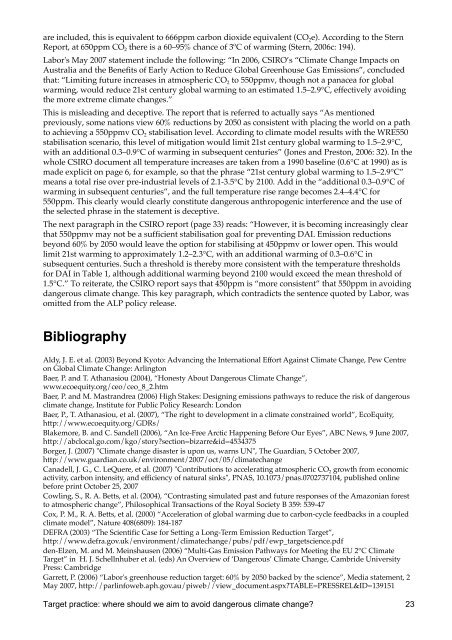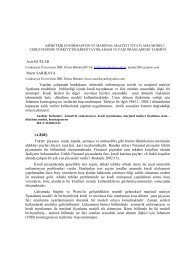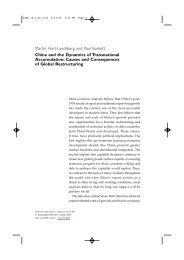where should we aim to prevent dangerous climate change?
where should we aim to prevent dangerous climate change?
where should we aim to prevent dangerous climate change?
You also want an ePaper? Increase the reach of your titles
YUMPU automatically turns print PDFs into web optimized ePapers that Google loves.
are included, this is equivalent <strong>to</strong> 666ppm carbon dioxide equivalent (CO 2 e). According <strong>to</strong> the SternReport, at 650ppm CO 2 there is a 60–95% chance of 3ºC of warming (Stern, 2006c: 194).Labor's May 2007 statement include the following: “In 2006, CSIRO’s “Climate Change Impacts onAustralia and the Benefits of Early Action <strong>to</strong> Reduce Global Greenhouse Gas Emissions”, concludedthat: “Limiting future increases in atmospheric CO 2 <strong>to</strong> 550ppmv, though not a panacea for globalwarming, would reduce 21st century global warming <strong>to</strong> an estimated 1.5–2.9°C, effectively avoidingthe more extreme <strong>climate</strong> <strong>change</strong>s.”This is misleading and deceptive. The report that is referred <strong>to</strong> actually says “As mentionedpreviously, some nations view 60% reductions by 2050 as consistent with placing the world on a path<strong>to</strong> achieving a 550ppmv CO 2 stabilisation level. According <strong>to</strong> <strong>climate</strong> model results with the WRE550stabilisation scenario, this level of mitigation would limit 21st century global warming <strong>to</strong> 1.5–2.9°C,with an additional 0.3–0.9°C of warming in subsequent centuries” (Jones and Pres<strong>to</strong>n, 2006: 32). In thewhole CSIRO document all temperature increases are taken from a 1990 baseline (0.6°C at 1990) as ismade explicit on page 6, for example, so that the phrase “21st century global warming <strong>to</strong> 1.5–2.9°C”means a <strong>to</strong>tal rise over pre-industrial levels of 2.1-3.5°C by 2100. Add in the “additional 0.3–0.9°C ofwarming in subsequent centuries”, and the full temperature rise range becomes 2.4–4.4°C for550ppm. This clearly would clearly constitute <strong>dangerous</strong> anthropogenic interference and the use ofthe selected phrase in the statement is deceptive.The next paragraph in the CSIRO report (page 33) reads: “Ho<strong>we</strong>ver, it is becoming increasingly clearthat 550ppmv may not be a sufficient stabilisation goal for <strong>prevent</strong>ing DAI. Emission reductionsbeyond 60% by 2050 would leave the option for stabilising at 450ppmv or lo<strong>we</strong>r open. This wouldlimit 21st warming <strong>to</strong> approximately 1.2–2.3°C, with an additional warming of 0.3–0.6°C insubsequent centuries. Such a threshold is thereby more consistent with the temperature thresholdsfor DAI in Table 1, although additional warming beyond 2100 would exceed the mean threshold of1.5°C.” To reiterate, the CSIRO report says that 450ppm is “more consistent” that 550ppm in avoiding<strong>dangerous</strong> <strong>climate</strong> <strong>change</strong>. This key paragraph, which contradicts the sentence quoted by Labor, wasomitted from the ALP policy release.BibliographyAldy, J. E. et al. (2003) Beyond Kyo<strong>to</strong>: Advancing the International Effort Against Climate Change, Pew Centreon Global Climate Change: Arling<strong>to</strong>nBaer, P. and T. Athanasiou (2004), “Honesty About Dangerous Climate Change”,www.ecoequity.org/ceo/ceo_8_2.htmBaer, P. and M. Mastrandrea (2006) High Stakes: Designing emissions pathways <strong>to</strong> reduce the risk of <strong>dangerous</strong><strong>climate</strong> <strong>change</strong>, Institute for Public Policy Research: LondonBaer, P., T. Athanasiou, et al. (2007), “The right <strong>to</strong> development in a <strong>climate</strong> constrained world”, EcoEquity,http://www.ecoequity.org/GDRs/Blakemore, B. and C. Sandell (2006), “An Ice-Free Arctic Happening Before Our Eyes”, ABC News, 9 June 2007,http://abclocal.go.com/kgo/s<strong>to</strong>ry?section=bizarre&id=4534375Borger, J. (2007) "Climate <strong>change</strong> disaster is upon us, warns UN", The Guardian, 5 Oc<strong>to</strong>ber 2007,http://www.guardian.co.uk/environment/2007/oct/05/<strong>climate</strong><strong>change</strong>Canadell, J. G., C. LeQuere, et al. (2007) "Contributions <strong>to</strong> accelerating atmospheric CO 2 growth from economicactivity, carbon intensity, and efficiency of natural sinks", PNAS, 10.1073/pnas.0702737104, published onlinebefore print Oc<strong>to</strong>ber 25, 2007Cowling, S., R. A. Betts, et al. (2004), “Contrasting simulated past and future responses of the Amazonian forest<strong>to</strong> atmospheric <strong>change</strong>”, Philosophical Transactions of the Royal Society B 359: 539-47Cox, P. M., R. A. Betts, et al. (2000) “Acceleration of global warming due <strong>to</strong> carbon-cycle feedbacks in a coupled<strong>climate</strong> model”, Nature 408(6809): 184-187DEFRA (2003) “The Scientific Case for Setting a Long-Term Emission Reduction Target”,http://www.defra.gov.uk/environment/<strong>climate</strong><strong>change</strong>/pubs/pdf/ewp_targetscience.pdfden-Elzen, M. and M. Meinshausen (2006) “Multi-Gas Emission Pathways for Meeting the EU 2°C ClimateTarget” in H. J. Schellnhuber et al. (eds) An Overview of ‘Dangerous’ Climate Change, Cambride UniversityPress: CambridgeGarrett, P. (2006) “Labor's greenhouse reduction target: 60% by 2050 backed by the science”, Media statement, 2May 2007, http://parlinfo<strong>we</strong>b.aph.gov.au/pi<strong>we</strong>b//view_document.aspx?TABLE=PRESSREL&ID=139151Target practice: <strong>where</strong> <strong>should</strong> <strong>we</strong> <strong>aim</strong> <strong>to</strong> avoid <strong>dangerous</strong> <strong>climate</strong> <strong>change</strong>? 23





